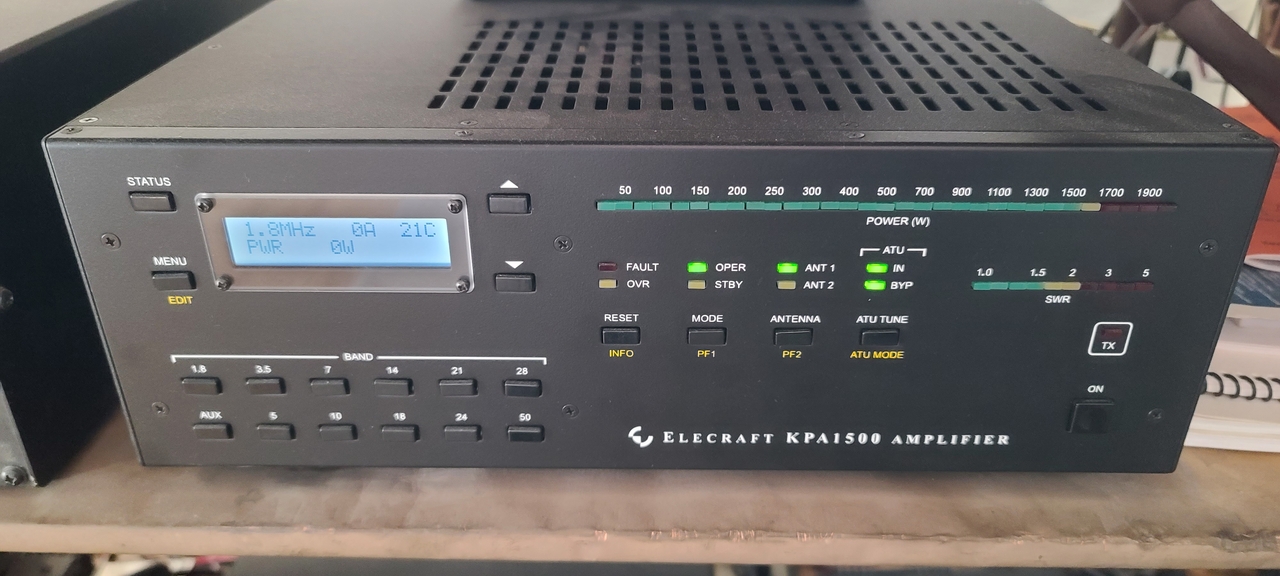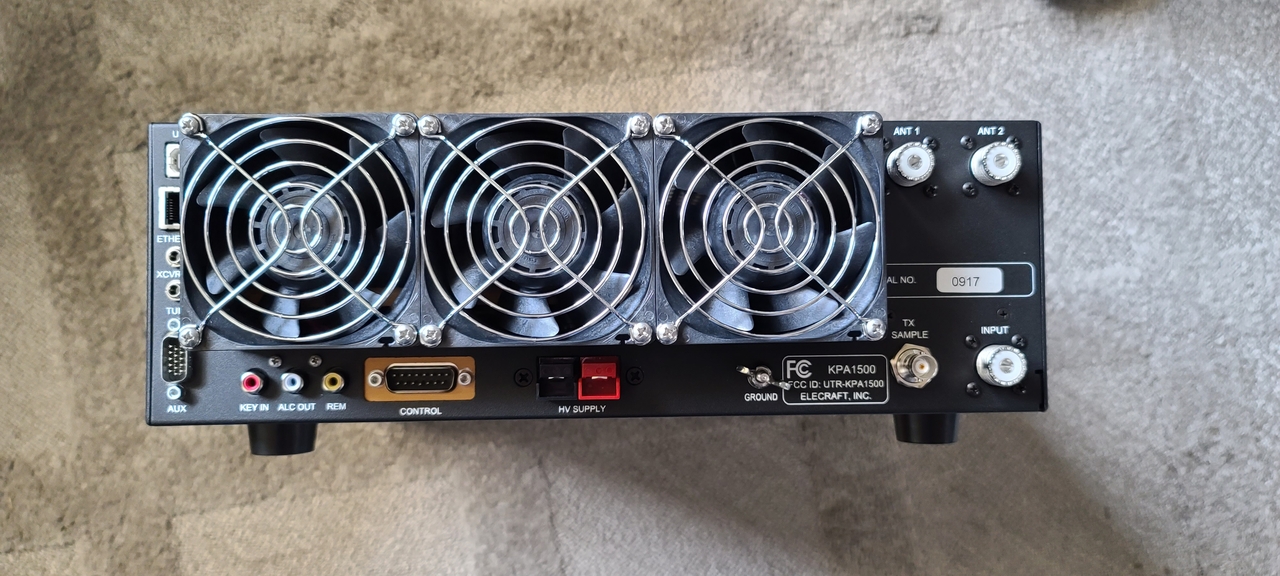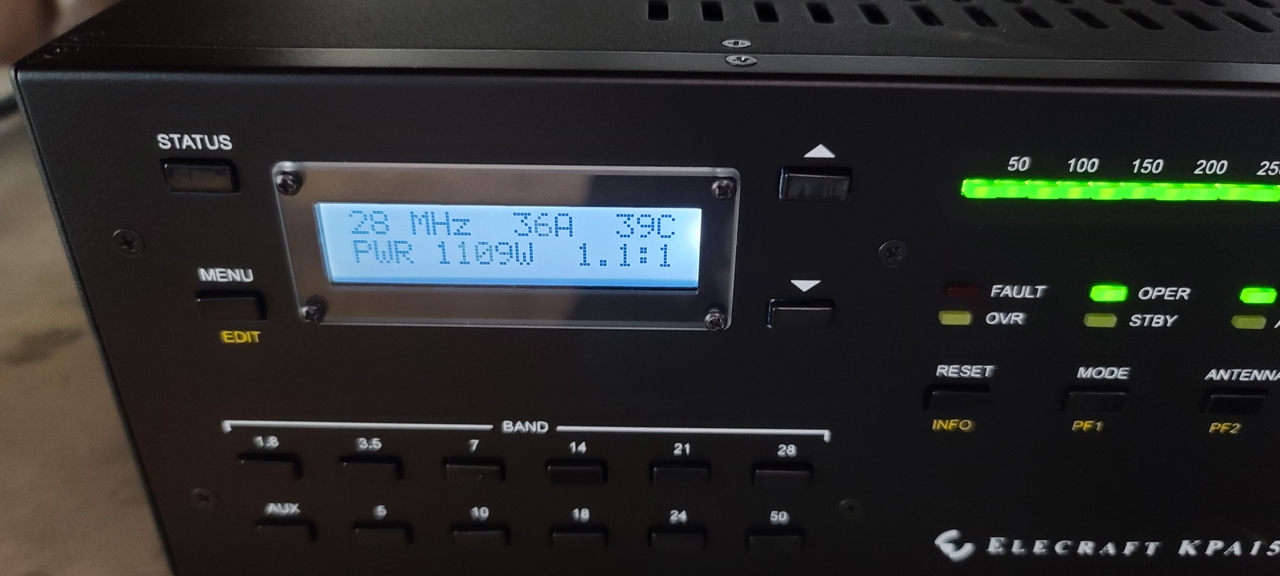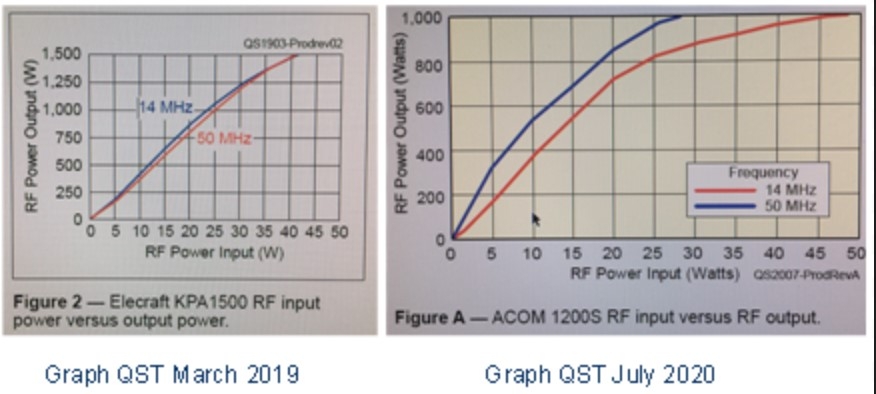Earlier this year, I decided to sell my trusty Ameritron AL-800H tube amp so I could purchase the Elecraft KPA1500 solid state 6-160 meters amplifier with built-in auto tuner. Boy am I glad I did.

My goals were fairly simple: I've been wanting to play QRO on 6 meters for years, and I was looking forward to the experience of changing bands without having to retune both the amp and the tuner. Initially I thought I might be able to eliminate the Ameritron ATR-30 tuner, but I ended up keeping it in line - more on that later.
The KPA1500's rich feature set is intended for use with any modern transceiver. My current HF rig is the Elecraft K3 (upgraded to the K3S), I purchased the matching Elecraft transceiver interface cable. The amp has several interface capabilities but my needs are pretty straight forward. I use the control cable to connect to the ACC port on the K3, the Key In line which runs to the iPlus mic/speaker switch box, the USB interface to my PC, and the requisite coax antenna/input connections.
The rear panel picture shows the additional interface features.

The ethernet connector provides an alternate control mechanism with the same functionality as USB but is useful for remote operations not involving a remote PC. Most of the other ports are for use with the various brands / types of HF rigs. The TX Sample line is for a future implementation of Pure Signal. Power is supplied by the included 50V power supply which can be positioned up to 10 feet away from the RF deck.
If you hook up the amp to a PC using either the USB or Ethernet interface, you can use Elecraft's KPA1500 Utility app to view everything that is going on. You can also see all of these details using the front panel and controls. Unless there are specific questions, I won't go into all of the intricate details of what is monitored by these controls as the manual is pretty clear and concise.

Using this amplifier is a complete joy. If you have the amp fully interfaced to your rig, it auto switches bands when you change bands on your rig. The ATU remembers the best setting for a particular "segment" in each band; the number of "segments" varies per band and the number of segments can be configured. When you switch bands using either the rig or the amp front panel, the internal ATU switches to the saved setting for the nearest operating frequency that it reads from the rig. If the ATU is engaged, it will automatically tune if the SWR is higher than the user-definable SWR threshold setting. Note that this frequency tracking feature can be turned on or off and is really useful if you have multiple antennas connected via external switch to each port. If you want to manually initiate the ATU, pressing the ATU TUNE button automatically switches the attached rig to CW mode, changes the rig power level to 20 watts (also user configurable) tunes the antenna, and then switches the rig back to the previous operating mode. It's all very slick.
You can set the preferred antenna output per band, as well as default whether the ATU is engaged by band. As an example, in my station I have a 6 meter M2 3 element beam tuned for the lower portion of the band input to ANT 2. When I select 6m, the amp auto selects the correct antenna and bypasses the ATU. If you have a specific band set to default to a particular antenna port, it will always remember to choose that port even if you later select the alternate antenna.
I have read other reviews that complain about the power supply fan noise. I just don't understand those reviewers' perspective as this amp fan noise is WAAAY less than anything I experienced with a tube amp. The fans on both the power supply and RF deck automatically adjust speed based on internal temperature and when they kick up the speed, they cool things down pretty quickly and settle back down. I just don't find the noise an issue, at all.
The internal ATU is rated to handle 3:1 SWR at 1500 watts and varies from there based on the presented impedance. The amp will require turning down the drive / power output if you exceed the presented SWR limit. I've found that that the ATU will tune up just about anything I give it, and backing the power down from the amp limit will still allow you to operate with considerable power with all kinds of oddball mismatches. When I want to use the amp, I regularly operate around 1200+ watts without worrying about what the internal ATU is doing across the band. On the other hand, my 80 meter antenna has a very narrow bandwidth, which is why I opted to keep the Ameritron ATR-30 manual tuner inline, using it to deliver max smoke from the Elecraft amp while bypassing its internal ATU once the SWR is higher than the Elecraft ATU likes.
One note on linearity. QST published a linearity test between the Elecraft KPA1500 and the ACOM 1200S a few years ago. Here is the graph they published that tells the story on both 20m and 6m:

The straighter the line/curve the more linear the amp is. These charts show that the KPA1500 amp is quite linear on both bands all the way to its rated power output. Unfortunately, the Acom 1200s doesn't perform nearly as well.
This amp is called a "legal limit" amp, but it will do more than that. In my tests, it appears that the amp has an auto protection trip at 1800 watts. One neat additional trick that you get with the Elecraft K3 (and I presume the K4) is that since the rig knows when you have the amp enabled, it can remember the transceiver power output setting per band both with the amp on and when off. So if you decide to turn the amp on, the rig automatically adjusts the power output to the level last used with the amp on that band. Again, this is very slick.
After using it for the better part of this year, I am still in love with the Elecraft KPA1500. It is not an inexpensive purchase, but this falls into the category of "you get what you pay for". I'm hoping that Elecraft introduces the Pure Signal capabilities soon; that will put it at the top of its class at signal purity.

My goals were fairly simple: I've been wanting to play QRO on 6 meters for years, and I was looking forward to the experience of changing bands without having to retune both the amp and the tuner. Initially I thought I might be able to eliminate the Ameritron ATR-30 tuner, but I ended up keeping it in line - more on that later.
The KPA1500's rich feature set is intended for use with any modern transceiver. My current HF rig is the Elecraft K3 (upgraded to the K3S), I purchased the matching Elecraft transceiver interface cable. The amp has several interface capabilities but my needs are pretty straight forward. I use the control cable to connect to the ACC port on the K3, the Key In line which runs to the iPlus mic/speaker switch box, the USB interface to my PC, and the requisite coax antenna/input connections.
The rear panel picture shows the additional interface features.

The ethernet connector provides an alternate control mechanism with the same functionality as USB but is useful for remote operations not involving a remote PC. Most of the other ports are for use with the various brands / types of HF rigs. The TX Sample line is for a future implementation of Pure Signal. Power is supplied by the included 50V power supply which can be positioned up to 10 feet away from the RF deck.
If you hook up the amp to a PC using either the USB or Ethernet interface, you can use Elecraft's KPA1500 Utility app to view everything that is going on. You can also see all of these details using the front panel and controls. Unless there are specific questions, I won't go into all of the intricate details of what is monitored by these controls as the manual is pretty clear and concise.

Using this amplifier is a complete joy. If you have the amp fully interfaced to your rig, it auto switches bands when you change bands on your rig. The ATU remembers the best setting for a particular "segment" in each band; the number of "segments" varies per band and the number of segments can be configured. When you switch bands using either the rig or the amp front panel, the internal ATU switches to the saved setting for the nearest operating frequency that it reads from the rig. If the ATU is engaged, it will automatically tune if the SWR is higher than the user-definable SWR threshold setting. Note that this frequency tracking feature can be turned on or off and is really useful if you have multiple antennas connected via external switch to each port. If you want to manually initiate the ATU, pressing the ATU TUNE button automatically switches the attached rig to CW mode, changes the rig power level to 20 watts (also user configurable) tunes the antenna, and then switches the rig back to the previous operating mode. It's all very slick.
You can set the preferred antenna output per band, as well as default whether the ATU is engaged by band. As an example, in my station I have a 6 meter M2 3 element beam tuned for the lower portion of the band input to ANT 2. When I select 6m, the amp auto selects the correct antenna and bypasses the ATU. If you have a specific band set to default to a particular antenna port, it will always remember to choose that port even if you later select the alternate antenna.
I have read other reviews that complain about the power supply fan noise. I just don't understand those reviewers' perspective as this amp fan noise is WAAAY less than anything I experienced with a tube amp. The fans on both the power supply and RF deck automatically adjust speed based on internal temperature and when they kick up the speed, they cool things down pretty quickly and settle back down. I just don't find the noise an issue, at all.
The internal ATU is rated to handle 3:1 SWR at 1500 watts and varies from there based on the presented impedance. The amp will require turning down the drive / power output if you exceed the presented SWR limit. I've found that that the ATU will tune up just about anything I give it, and backing the power down from the amp limit will still allow you to operate with considerable power with all kinds of oddball mismatches. When I want to use the amp, I regularly operate around 1200+ watts without worrying about what the internal ATU is doing across the band. On the other hand, my 80 meter antenna has a very narrow bandwidth, which is why I opted to keep the Ameritron ATR-30 manual tuner inline, using it to deliver max smoke from the Elecraft amp while bypassing its internal ATU once the SWR is higher than the Elecraft ATU likes.
One note on linearity. QST published a linearity test between the Elecraft KPA1500 and the ACOM 1200S a few years ago. Here is the graph they published that tells the story on both 20m and 6m:

The straighter the line/curve the more linear the amp is. These charts show that the KPA1500 amp is quite linear on both bands all the way to its rated power output. Unfortunately, the Acom 1200s doesn't perform nearly as well.
This amp is called a "legal limit" amp, but it will do more than that. In my tests, it appears that the amp has an auto protection trip at 1800 watts. One neat additional trick that you get with the Elecraft K3 (and I presume the K4) is that since the rig knows when you have the amp enabled, it can remember the transceiver power output setting per band both with the amp on and when off. So if you decide to turn the amp on, the rig automatically adjusts the power output to the level last used with the amp on that band. Again, this is very slick.
After using it for the better part of this year, I am still in love with the Elecraft KPA1500. It is not an inexpensive purchase, but this falls into the category of "you get what you pay for". I'm hoping that Elecraft introduces the Pure Signal capabilities soon; that will put it at the top of its class at signal purity.
